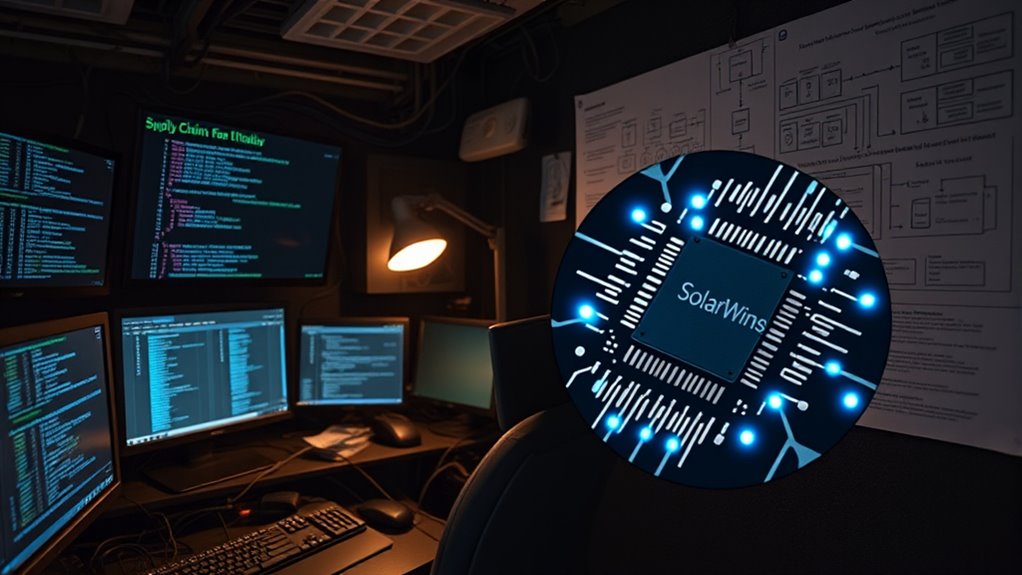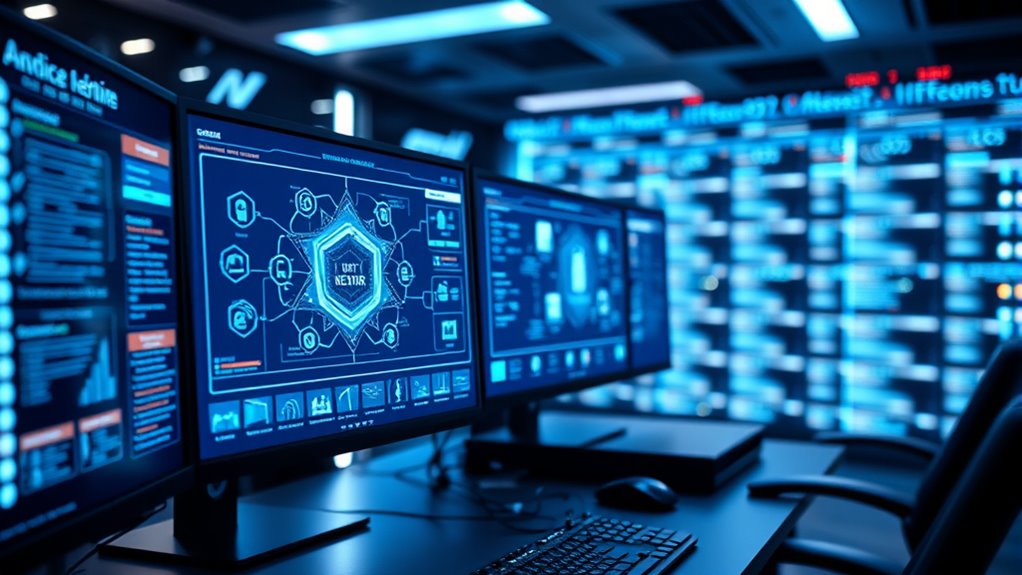The SolarWinds attack shows that supply-chain hacks can expose your organization to massive risks. Attackers exploited vulnerabilities in trusted software updates, allowing them to infiltrate government and private networks unnoticed. To protect yourself, focus on tightening security in your supply chain, implementing rigorous vetting, and monitoring for unusual activity. If you stay alert to these tactics and strategies, you’ll better understand how to defend against similar threats in the future. Keep exploring to learn more.
Key Takeaways
- The SolarWinds attack exploited supply chain vulnerabilities via malicious code in software updates, affecting thousands globally.
- Advanced techniques like code obfuscation, infrastructure rotation, and steganography helped hackers evade detection.
- Continuous monitoring, rigorous supply chain security, and stakeholder collaboration are critical to prevent similar breaches.
- Embedding cybersecurity into procurement and operational processes enhances resilience against supply chain attacks.
- Regular security reviews, supplier audits, and adopting AI-driven risk assessments strengthen defenses against complex threats.
Understanding the Scope and Impact of the SolarWinds Attack

How extensive was the SolarWinds attack, and what were its consequences? The breach affected around 18,000 organizations through malicious updates distributed via SolarWinds Orion from March to June 2020. SolarWinds informed roughly 33,000 customers, with 18,000 impacted by malware. High-profile victims included U.S. government agencies like the Justice, Treasury, Commerce, and Homeland Security departments, along with private firms like Microsoft and FireEye. The attack’s reach extended globally, infecting over 50 Danish organizations and compromising networks at top U.S. federal agencies. These targets suffered unauthorized access, email infiltrations, and data breaches. The breach triggered emergency responses, including network shutdowns and reviews of cybersecurity practices. Its scale and severity made it one of the most significant cyberattacks in history, exposing critical supply chain vulnerabilities. Additionally, the incident underscored the importance of cybersecurity resilience in protecting national security and corporate infrastructure.
Unpacking the Attack Methodology and Technical Exploitation Techniques

The SolarWinds attack employed a highly sophisticated methodology that exploited vulnerabilities in the company’s supply chain, enabling hackers to insert malicious code directly into legitimate software updates. They gained access to SolarWinds’ development pipeline, manipulating the CI/CD process by deploying malware called SUNSPOT that subtly altered source code. The attackers used dynamic resolution techniques to keep the malware hidden and employed code obfuscation to thwart detection. They rotated infrastructure frequently, leveraging geolocation to evade security tools. To hide their activities, they used steganography and memory-based execution, making detection difficult. The hackers also performed clean-up operations to remove traces of their presence. This layered approach allowed them to maintain stealth while distributing malicious updates to over 18,000 customers worldwide. This attack demonstrated the importance of rigorous supply chain security measures and continuous monitoring to detect advanced persistent threats. Implementing proactive threat detection strategies can further strengthen defenses against such complex exploits.
Key Strategies for Mitigating Future Supply-Chain Security Risks

To effectively mitigate future supply-chain security risks, organizations must implement extensive strategies that address governance, risk assessment, and resilience. You should establish cohesive governance structures that integrate cyber risk management across all supply chain functions, fostering collaboration among stakeholders to improve visibility and response coordination. Embed cybersecurity practices into procurement, compliance, and operations, and develop shared policies to standardize expectations. Regularly review and update frameworks to adapt to evolving threats. Conduct continuous threat-based evaluations of suppliers and use advanced risk assessment methodologies. Leverage technologies like automation and AI for monitoring, and require suppliers to adopt secure processes, conduct audits, and ensure traceability. Cultivate an organizational culture that emphasizes agility, scenario planning, ongoing learning, and proactive defense to stay ahead of emerging risks. Incorporating yoga techniques into employee wellness programs can also improve focus and resilience in managing complex security challenges.
Frequently Asked Questions
How Did Attackers Maintain Long-Term Access Without Detection?
You wonder how attackers stay hidden long-term. They achieve this by injecting malware into trusted software updates, blending malicious activity with legitimate network traffic, and using high-level privileges to maintain access. They cleverly delete traces, set up backdoors, and exploit trusted accounts, making detection difficult. Their stealth tactics, like delaying activation and mimicking normal operations, allow them to remain undetected for months or even years.
What Specific Vulnerabilities in Solarwinds’ Software Enabled the Attack?
You want to know what specific vulnerabilities in SolarWinds’ software enabled the attack. The SUNBURST backdoor exploited trusted software updates and a compromised build process, allowing malware to blend in undetected. CVE-2020-10148 let attackers bypass authentication, while the lack of proper verification for signed updates enabled malicious code insertion. Outdated versions and insufficient security controls further facilitated the breach, giving attackers multiple entry points and persistent access.
Are Smaller Vendors at Similar Risk of Supply-Chain Compromises?
You’re right to ask if smaller vendors face similar risks of supply-chain compromises. The answer is yes. They’re especially vulnerable because they often lack robust cybersecurity defenses and visibility, making them easy targets for cybercriminals. When a small vendor gets compromised, it can cascade through the entire supply chain, threatening larger organizations too. Without proper security measures, these vendors become weak links that attackers exploit to access bigger targets.
How Can Organizations Verify the Integrity of Software Updates Effectively?
Imagine you’re a gatekeeper, guarding a castle. To verify software updates, you use cryptographic signatures like a secret handshake, ensuring only trusted messengers deliver genuine packages. You check update signatures, compare checksums, and enforce strict key management, like locking gates and training your guards. Automate these checks within your pipeline, and foster a security-aware culture, so every update is verified, keeping your castle safe from malicious intruders.
What Legal and Ethical Considerations Arise From Nation-State Cyberattacks?
You need to recognize that nation-state cyberattacks raise complex legal and ethical issues. Legally, you must consider international laws, self-defense rights, and the importance of peaceful dispute resolution. Ethically, respect for sovereignty, human rights, and non-intervention principles are essential. You also face dilemmas about retaliation and responsibility, emphasizing the need for global cooperation and clear rules to navigate these threats responsibly and uphold international stability.
Conclusion
Now that you’ve seen how the SolarWinds breach unfurled like a silent storm, it’s clear that securing your supply chain is like anchoring a ship in turbulent waters. Stay vigilant, update your defenses, and think of your security measures as a sturdy lighthouse guiding you through the fog. Only by lighting the way can you prevent unseen threats from crashing ashore and keep your digital harbor safe from future storms.









